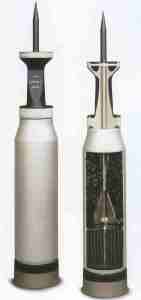
A type of kinetic energy ammunition where a sub-calibre penetrator of heavy material is surrounded by a light weight 'pot' or sabot which supports the penetrator in the barrel. The use of the sabot ensures that the largest possible base area is presented to the propellant gases over which pressure can be exerted. The sabot falls to the ground a few hundred metres from the barrel, leaving the sub-calibre penetrator to continue to the target.
A penetrator of a dense material (high grade steel, tungsten or depleted uranium) is surrounded by a light-weight 'pot' or circular support, the object of which is to present the largest possible base area within the barrel, over which the propellant gas can exert pressure. The projectile is accelerated very quickly up the barrel and once it exits from the muzzle the air resistance causes the 'pot' to fall off allowing the smaller diameter penetrator to continue towards the target. The penetrator normally has a ballistically shaped outer shell or cap to make it more aerodynamic in flight. This ballistic casing normally shatters on contact with the armour, leaving the solid core to penetrate.
Depth of penetration at the target will depend not only on the residual energy of the shot but also on its shape and size. The shape of the curve at the head of the penetrator (the ogive) is most important as it must not only be able to pierce the armour but must 'turn into' it to reduce the advantage of sloped armour and not ricochet. Ideally, the penetrator must not break up, should pass through taking as much armour material with it as possible and should break up inside the tank and not exit on the far side, expending all its energy within the vehicle. If, for a given mass, the diameter of the penetrator is reduced and its length is increased, then for the same residual velocity, it will penetrate a greater thickness of armour as it will be expending its energy over a smaller cross-sectional area. The ratio of the length-to-diameter is called the 'slenderness' ratio or length/diameter ratio and although a projectile with a ratio in excess of 7:1 cannot be spin-stabilised it is not until they reach a ratio of approximately 20:1 that they can be called 'long rods'. The long rod penetrator has been the most significant advance in kinetic energy ammunition in recent years though the idea itself is far from new. The most famous application of the principal of the long rod penetrator was the arrow used by the medieval archers to defeat the armoured knight.